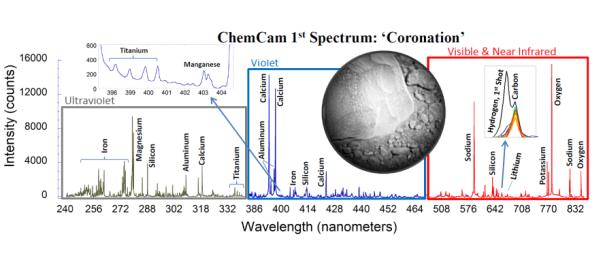This is the first laser spectrum from the Chemistry and Camera (ChemCam) instrument on NASA's Curiosity rover, sent back from Mars on August 19, 2012. The plot shows emission lines from different elements present in the target, a rock near the rover's landing site dubbed "Coronation" (see inset).
ChemCam's detectors observe light in the ultraviolet (UV), violet, visible and near-infrared ranges using three spectrometers, covering wavelengths from 240 to 850 nanometers. The light is produced when ChemCam's laser pulse strikes a target, generating ionized gases in the form of plasma, which is then analyzed by the spectrometers and their detectors for the presence of specific elements. The detectors can collect up to 16,000 counts produced by the light in any of its 6,144 channels for each laser shot.
The plot is a composite of spectra taken over 30 laser shots at a single 0.016-inch (0.4-millimeter) diameter spot on the target. An inset on the left shows detail for the minor elements titanium and manganese in the 398-to-404-nanometer range. An inset at the right shows the hydrogen and carbon peaks. The carbon peak was from the carbon dioxide in Mars' air. The hydrogen peak was only present on the first laser shot, indicating that the element was only on the very surface of the rock. Magnesium was also slightly enriched on the surface. The heights of the peaks do not directly indicate the relative abundances of the elements in the rock, as some emission lines are more easily excited than others.
A preliminarily analysis indicates the spectrum is consistent with basalt, a type of volcanic rock, which is known from previous missions to be abundant on Mars. Coronation is about three inches (7.6 centimeters) across, and located about 5 feet (1.5 meters) from the rover and about nine feet (2.7 meters) from ChemCam on the mast.
JPL manages the Mars Science Laboratory/Curiosity for NASA's Science Mission Directorate in Washington. The rover was designed, developed and assembled at JPL, a division of the California Institute of Technology
in Pasadena.
For more about NASA's Curiosity mission, visit: http://www.jpl.nasa.gov/msl, http://www.nasa.gov/mars, and
http://marsprogram.jpl.nasa.gov/msl.

 Planetary Data System
Planetary Data System












